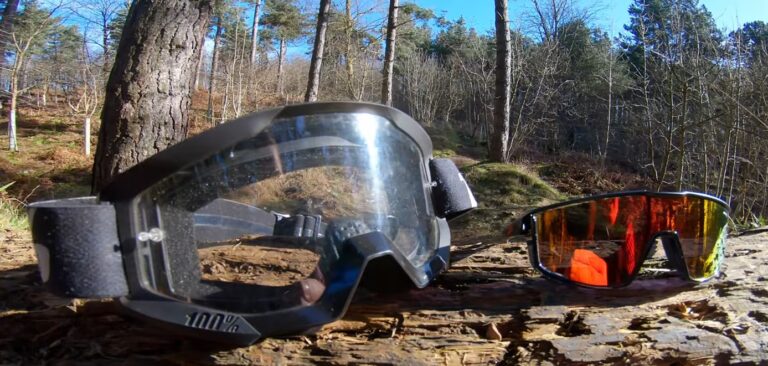Mountain bike goggles vs ski goggles may seem similar at first glance, but there are some key differences that make them better suited for their respective sports.
The difference between mountain bike goggles vs ski goggles is that MTB goggles are used to protect eyes from debris, pebbles, branches, dirt, and water while ski goggles are used to keep eyes warm and get a clear view in the snow.
Mountain bike goggles typically have a wider field of view, which is important for spotting obstacles on the trail.
They also usually have vents to help prevent fogging, and some even have polarized lenses to reduce glare.
Ski goggles, on the other hand, are designed to protect your eyes from the bright sun and icy wind at the top of the mountain.
They typically have a narrower field of view, but their lenses are usually much bigger, which provides better coverage and protection from the elements.
Lens Difference

When it comes to mountain biking and skiing, there are a few key differences that you need to take into account when choosing the right pair of goggles.
Here’s a quick rundown of the main lens differences between mountain bikes and ski goggles:
Mountain bike goggles tend to have larger lenses, which provide better peripheral vision while riding.
Ski goggles usually have a double lens design, which helps to prevent fogging.
The lenses in ski goggles are also often curved, which helps to reduce glare from the sun and snow.
Eye Protection Difference
When it comes to eye protection, there are a few key differences between mountain bike goggles and ski goggles.
For one, mountain bike goggles tend to be more aerodynamic, which is important for cyclists who are trying to minimize drag.
Ski goggles, on the other hand, are designed to provide a wider field of vision and help prevent snow blindness.
Another key difference is that mountain bike goggles usually have vents to help prevent fogging, while ski goggles typically do not.
Finally, ski goggles are often made with a double lens to provide better insulation against the cold, while most mountain bike goggles have a single lens.
Size Difference

Mountain bike goggles and ski goggles may look similar, but there are some key differences between them. One of the most notable differences is size.
Mountain bike goggles tend to be much smaller than ski goggles. This is because they need to fit snugly around your helmet, and they also need to provide a wider field of view.
Ski goggles, on the other hand, are designed to fit over your ski helmet and provide a more limited field of view.
Ventilation Difference
Mountain bike goggles typically have more Ventilation than ski goggles. This is because when you’re riding a bike, you generate more body heat than when you’re skiing.
The extra Ventilation helps to keep your eyes cool and comfortable.
Glare Difference

Ski goggles are designed to protect your eyes from the bright sun and reflected light off the snow. They typically have a larger lens surface area and a darker tint.
This helps reduce the amount of light that hits your eyes, reducing glare and making it easier to see on the slopes.
Mountain bike goggles, on the other hand, are designed to give you a wider field of view and don’t usually have as large of a lens surface area. This allows more light to hit your eyes, resulting in more glare.
However, mountain bike goggles typically have a polarized lens that helps reduce some of the glare
Staying Warm
Mountain bike goggles are designed to protect your eyes from the elements, including the sun, wind, and dust. They typically have a larger lens than ski goggles, which helps to keep more of the elements out of your eyes.
Mountain bike goggles also have a thicker frame, which helps to keep your eyes protected from the elements.
Ski goggles are designed to protect your eyes from the sun and wind. They typically have a smaller lens than mountain bike goggles, which helps to keep more of the sun and wind out of your eyes.
Ski goggles also have a thinner frame, which helps to keep your eyes from getting too cold in the wind.
Contrast
The main difference between mountain bike goggles and ski goggles is the amount of ventilation. Mountain bike goggles usually have more ventilation to prevent fogging, while ski goggles have less ventilation to keep warmth in.
Ski goggles also tend to be larger and have a thicker lens to provide more protection from the elements. When choosing between the two, it really depends on what you’ll be using them for.
If you’re mostly riding in warm weather, mountain bike goggles will likely be the better option.
However, if you’re riding in colder conditions or doing any type of racing, ski goggles may be the better choice.
Can You Use Ski Goggles For Mountain Biking
Yes, you can use ski goggles for mountain biking. However, there are a few things to keep in mind before using them. Ski goggles are designed to protect your eyes from the bright sun and cold wind.
Mountain biking generally takes place in cooler temperatures and in more varied terrain than skiing, so you’ll want to make sure the goggles you choose offer good ventilation and don’t fog up.
You’ll also want to make sure the lenses are durable enough to withstand the rigors of mountain biking.
Choose a pair of ski goggles that offer 100% UV protection and that fit snugly without being too tight.
Can You Use Mountain Bike Goggles Lenses In Ski Goggles

Mountain bike goggles and ski goggles may look similar, but they serve different purposes.
Mountain bike goggles are designed to protect your eyes from dirt, dust, and debris, while ski goggles are designed to protect your eyes from the sun’s harmful rays.
While you can use mountain bike goggles lenses in ski goggles, it is not recommended as they will not provide the same level of protection.
If you are looking for a pair of goggles that can be used for both mountain biking and skiing, we recommend purchasing a pair of ski goggles with interchangeable lenses.
This way, you can have one pair of goggles that meets all your needs.


